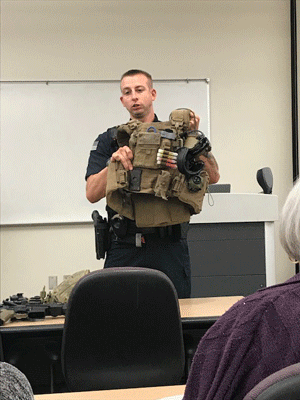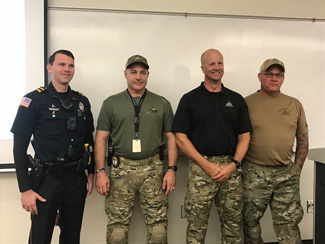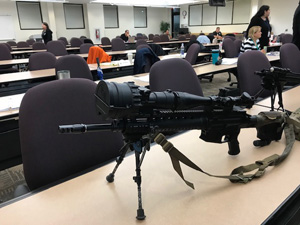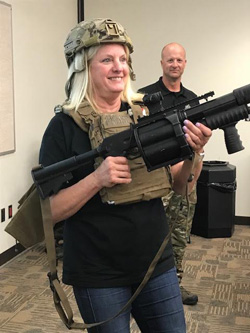Week 11 of the Garland Citizens Police Academy included presentations from the Bomb Unit and Special Weapons and Tactics (SWAT) Unit. These units are typically called out in very dangerous circumstances and stress levels are excessive.
On a lighter note, it didn’t take me long to realize that these units are the ones with the coolest toys.
Bomb Unit
Tony Blasingame talked to the class about the Bomb Unit which began in 1971, was inactive for a few years and reactivated in 1989. I was surprised to learn that the United States government decides how many bomb techs each unit has. There are seven bomb techs in the Garland Police Department and approximately 437 units in the U.S. The unit at GPD covers eight counties that include 60 cities.
Testing and training are grueling. Basic bomb tech school lasts six weeks. Students receive several large binders of information and must not only learn everything covered in the binders but also must remember everything the instructor says. The test could include information from both sources. Additionally, good math skills are a requirement for the job. They have to recertify every three years to prove to the FBI that they can still do the job and techs have to have secret level clearance to attend the classes.
The physical requirements are just as taxing because bomb techs must also have the ability to do everything that SWAT team  members do.
members do.
The unit has equipment that includes special containment trailers, breaching vehicles, response vehicles, and a total containment vessel. They have four robots, which become obsolete quickly.
One of the students volunteered to put on the protective suit that bomb techs wear and just looking at him nearly pushed me into a panic attack. This job is definitely not for claustrophobic people.
In addition to their jobs as bomb techs, they are also trained hazmat techs.
SWAT team
Lt. Colasanto and several members of the SWAT team were on hand to tell us about their unit. SWAT officers are part-time in that they have other jobs in GPD. There are SWAT officers from just about every area of the department.
The selection process for SWAT is physically and mentally grueling. Applicants are checked out thoroughly. Their personnel records, commendations, past use of force, previous training, sick leave records and much more are taken into account. There are psychological evaluations, weapons qualifications, as well as what they call a “gut check,” which provides information about their teamwork, physical and mental toughness, shooting skills and more. Fellow team members must be confident that anyone they work with, even at the height of exhaustion, can still do their best.
teamwork, physical and mental toughness, shooting skills and more. Fellow team members must be confident that anyone they work with, even at the height of exhaustion, can still do their best.
SWAT consists of the command staff, snipers, assault teams, intelligence, negotiators and command post. The total number of officers is 28, 20 assault, four snipers and four lieutenants.
Assault teams are made up of four individuals. The point person enters the structure first. Next in is the cover person, then the team leader and rear guard.
They are commonly called out on cases where someone has barricaded himself in a structure and in hostage situations. They also serve high-risk warrants.
SWAT team members have special gear including a helmet with night vision and infrared lights so they can see each other. Their bullet-proof vests are equipped with a camera pocket, smoke grenade pouch, shears, tourniquet, notepad and more. They also have push to talk headsets.
There are tools and guns, some that shoot up to 1,000 yards, for all situations.
Both of these jobs are high-risk and high-stress and not for everyone.


